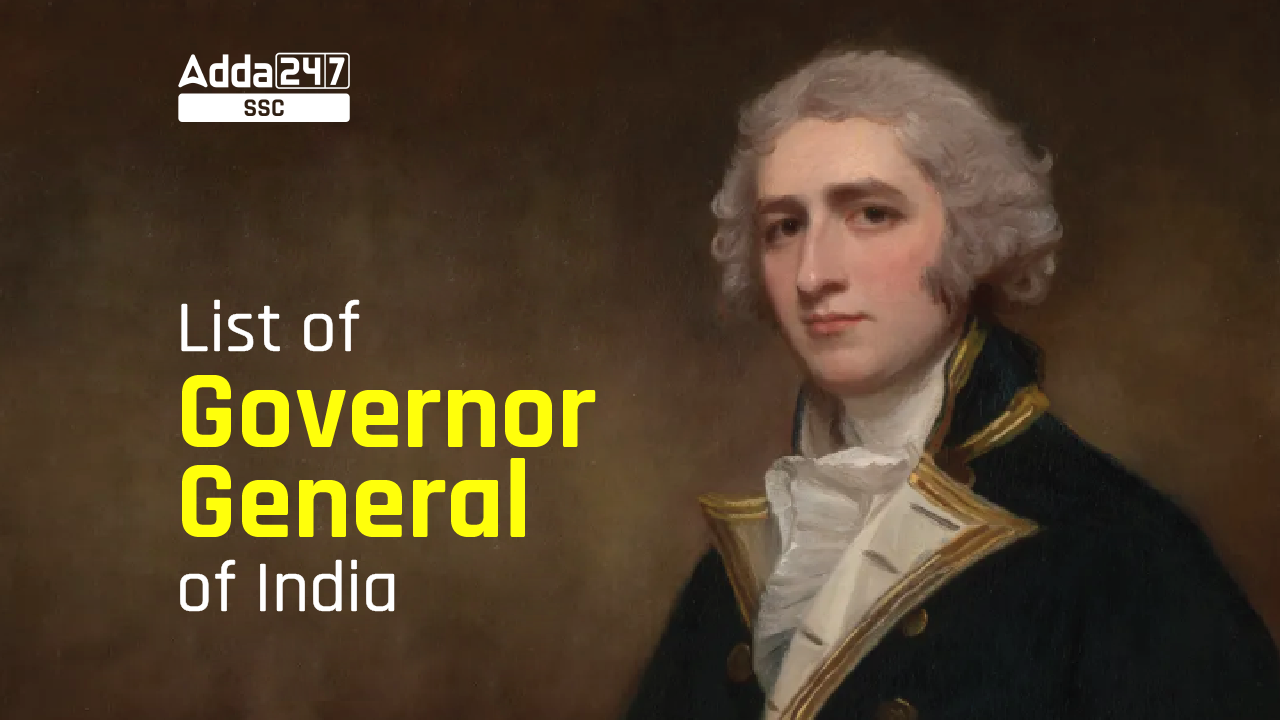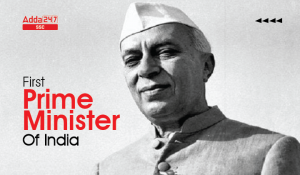List of Governors-Generals of India: General Awareness is an important section in many competitive exams. It can help candidates score well in a short amount of time. In this section, candidates are not required to perform complex calculations. Instead, they should be prepared with facts and figures in advance. One important topic in General Awareness is the Governor-Generals of India. This was the title of the head of state of British India from 1773 to 1947. The Governor-General was appointed by the British Crown and was responsible for the administration of British India.
Candidates are sometimes confused between the first Governor General of Bengal and that of India. This article gives a clear timeline starting from 1772 via 1828 to 1947 showing the various Governor Generals and important events that took place while they were in power. By being familiar with this List of Governor General of India, facts and figures, candidates can increase their chances of scoring well on the General Awareness section of competitive exams and securing a government job.
List of Governor General of India: Overview
The name of the post was Governor General of Bengal in the beginning and then got changed to Governor General of India. The first Governor General of Bengal was Warren Hastings. He was appointed to this position in 1772. This arrangement went on till 1828 and in the same year, Lord William Bentick was appointed as the first Governor General of India. Check the list of Governor Generals Of India below.
Sir Robert Clive
- He was the first & last Governor of Bengal. He remained the Governor of Bengal twice.
- He started the concept of the Dual Government or “Diarchy” in Bengal.
- He was known as the Kingmaker of the Bengal.
- Sir Robert Clive (1725-1774) was a British military officer and administrator who played a significant role in establishing British rule in India.
- He committed suicide after returning back to England in 1772.
Governor Generals of Bengal (1772-1828)
Warren Hastings (1772-1785)
- Warren Hastings was the first Governor-General of Bengal (Presidency of Fort William). In 1750 he joined the British East India Company as a clerk and sailed out to India, reaching Calcutta in August 1750.
- Hastings played a crucial role in expanding British control over India. During his tenure, he introduced significant reforms in the administration, judicial and revenue systems.
- In 1781, he founded the Calcutta Madrasa, for the promotion of Islamic studies.
- He founded the Asiatic Society of Bengal with William Jones in 1784.
- Zamindars were given judicial powers; and established civil and criminal courts in each district.
- Under this:-(i) The concept of dual govt. & Diarchy ended in Bengal. (ii) The Supreme Court was set up at Calcutta (1774) with a total of 4 judges.
- During his period, Geeta was translated into English by “Charles Wilkins”.
- The first newspaper of India “The Bengal Gazette” was started in 1780 by “Mr. James Hickey”.
- 2nd Anglo-Mysore war was fought.
Lord Cornwallis (1786-1793)
- Lord Cornwallis (1738-1805) was a British military commander and colonial administrator who served as the Governor-General of India from 1786 to 1793. He was born in London, England and began his military career in the British Army in 1756.
- Cornwallis played a crucial role in the American Revolutionary War, where he served as the commander of British forces. He surrendered to American forces at the Siege of Yorktown in 1781, which effectively ended the war.
- After his defeat in America, Cornwallis was appointed as the Governor-General of India, where he introduced significant reforms in the administration and judicial systems. He also sought to expand British control over India, and his policies led to several conflicts, including the Second Mysore War and the Third Anglo-Maratha War.
- Introduced Permanent Settlement of Bengal (also called the Zamindari system). It was an agreement between East India Company and Bengali landlords to fix revenues to be raised from land.
- He started the civil service Examination in India in 1786. That is why he is known as the father of civil services. Mr. Satyendra Nath Tagore became the first person to qualify for the civil services examination.
- He introduced Police reforms according to which each district was divided into 400 square miles and placed under a police superintendent.
- 3rd Anglo-Mysore War was started (1789-1792)
National Emergency Definition, Introduction, Types: Article 352 and FAQs
Lord Wellesley(1798-1805)
- He started the concept of the Subsidiary alliance system in the year 1798 a system to keep the Indian rulers under control and to make the British the supreme power.
- He founded Fort William College at Calcutta.
- The 4th Anglo-Mysore War was fought in 1799 and Tipu Sultan was killed.
Sir George Barlow(1805-1807)
- First Sipahi Vidroh – The “Mutiny of Sepoys” took place in the year 1806 at Vellore (T.N) on the issue of the dress code. However, the mutiny was very small and was suppressed by the Britishers in only a few days.
Lord Minto I (1807-1813)
- Gilbert Elliot-Murray-Kynynmound, 1st Earl of Minto (1751-1814), also known as Lord Minto I, was a British colonial administrator who served as the Governor-General of India from 1807 to 1813. He was born in Edinburgh, Scotland, and was educated at the University of Edinburgh.
- He signed the famous Treaty of Amritsar in the year 1809 with Maharaja Ranjeet Singh after which it was decided that the Sikh empire will be concentrated up to the Satluj River.
- He passed the Charter Act of 1813. Under this: (a) The Britishers decided to give 1 lakh Rs. every year for education in India. (b) The trading Monopoly of the Britishers ended in India except for trading Tea & opium and trading with China.
Lord Hastings(1813-1823)
- Francis Rawdon-Hastings, 1st Marquess of Hastings (1754-1826), also known as Lord Hastings, was a British military commander and colonial administrator who served as the Governor-General of India from 1813 to 1823.
- He ended the policy of non-intervention, which was followed by Sir John Shore.
- He abolished the censorship of the press. Introduced Ryotwari and Mahalawari systems in Bombay.
Lord Amherst(1823-1828)
- William Pitt Amherst, 1st Earl Amherst (1773-1857), also known as Lord Amherst, was a British diplomat and colonial administrator who served as the Governor-General of India from 1823 to 1828.
- His tenure was known for the First Anglo-Burmese War (1824-26) and the Mutiny of Barrackpur (1824)
Governor Generals of India
Lord William Bentick (1828-1835)
- He carried out social reforms such as the abolition of Sati Pratha with the help of Rajaram Mohan Roy
- Suppression of Thugs, 1830.
- Established the first Medical College in Calcutta.
- He declared “English” the official language of India in the year 1835, on the advice of Lord Macaulay(Father of India Judicial System).
- He passed the Charter Act of 1833. Under this:-(a)The trading Monopoly of the Britishers Completely ended in India. (b)The post of Governor General of Bengal ended and the Governor General of India started. Thus he became the first “Governor General of India
- He also suppressed female infanticide and child sacrifice.
Sir Charles Metcalfe(1835-1836)
- Sir Charles Metcalfe (1785-1846) was a British colonial administrator who served as the Governor-General of India from 1835 to 1836.
- He removed all the restrictions on the Vernacular Press Act and made the press Independent. Owe to this he is known as the “Liberator of Press in India”.However, he was removed from his post.
Lord Auckland(1836-1842)
- George Eden, 1st Earl of Auckland (1784-1849), also known as Lord Auckland, was a British colonial administrator who served as the Governor-General of India from 1836 to 1842.
- The first Afghan War was fought during his reign.
Lord Dalhousie(1848-1856)
- Opened the first Railway line from Bombay to Thane in 1853.
- Opened the first Telegraph line from Calcutta to Agar in 1853.
- He issued the first Postal Stamp of India (1854).
- He started the Public Works Department (PWD) in India.
- He started the first Engineering College at Roorkee. (Presently IIT Roorkee)
- He made Shimla the summer capital.
- He passed the “Widow Remarriage Act”1856 on the efforts of “Eshwar Chandra Vidyasagar”.
- Introduced Doctrine of Lapse captured Satara (1848), Jaipur and Sambalpur (1849), Udaipur (1852), Jhansi (1853), and Nagpur (1854).
- Many bridges were constructed and started on Grand Trunk Road.
- He appointed the Education Commission known as “Wood’s Dispatch” in 1854 in order to improve university-level education in India.
- 3 universities were set up in India in the year 1857 at Calcutta, Bombay, and Madras.
- Mutiny of sepoys (Revolt of 1857) by a soldier named Mangal Panday at “Barrackpur in Bengal”
- Indigo Revolt or Nil Darpan took place in Bengal in 1859 by “Digambar Biswas & Bishnu Charan Biswas”
- Starting off the ASI → Archaeological Survey of India in 1861.
- He passed the Indian Council Act. Under this, the British Viceroy had the power to declare an emergency in India, and during the emergency, he had the power to pass any new law without anybody’s permission.
- Three High Courts were set up in India in 1862. At Calcutta, Bombay, and Madras.
- He started the Indian Forest Department, in 1865.
- He extended telegraphic communication up to the European countries.
- “Mohan Das Karamchand Gandhi” was born on 2nd October 1869 at Porbandar in the royal family of “Karamchand Gandhi” & “Putli Bai”.
- Lord Mayo conducted the first census of India. (1871)
- He started the Department of Agriculture and Commerce in India.
- He started the Statistical Survey of India (SSI) which later on became (ISI) (India Statistical Institute)
- He started the famous “Mayo College” at Ajmer and Rajkot College in Gujarat for Indian Prince and Princess.
- He was the only viceroy to be killed during his term of office by a Pathan known as “Sher Afridi” at Andaman, in 1872.
- He is known as the viceroy of the reverse character.
- “The Grand Delhi Darbar” of “1877” was set up for the welcome of Queen Victoria where she was given the title of “Kaiser-i-Hind”(Queen of India)
- Mr. Gopal Hari Deshmukh wore Khadi clothes during the grand Delhi Darbar of 1877.
- Lord Lytton reimposed all the Restrictions on the Press through the “Vernacular Press, Act” in 1878.
- He reduced the Maximum age for Indians to quality the civil services exam from (21 to 18 years)
- He passed the Arm’s Act of 1878. Under this, it was mandatory to acquire a license for keeping the arms.
- He appointed the “famine commission” in 1876 under “Sir Richard Strachey” and he also gave relief to the farmers by waving off their taxes.
- He passed the first Factory Act, of 1881, under which child Labour was prohibited in India.
- He passed the Ilbert Bill, in 1883, under this the Indian judges got the power to sentence the European criminals but later on this Bill was withdrawn by the Britishers.
- He appointed the education commission, known as the “Hunter Commission” in 1882 in order to improve secondary-level education in India.
- He passed the local self-government Act in 1882 under this the Panchayati Raj system started in India. That is why he is known as the “father of the Panchayati Raj” or father of Local self-government.
- Formation of the Indian National Congress (INC) in the year 1885 at Gokul Das Tejpal Sanskrit Mahavidyalaya, Bombay by Mr. A. O. Hume with a total of 72 members.
- He passed the Second Factory Act of 1891, under this:-(i) There was a weekly holiday for the workers (Sunday Holiday). (ii) Fixed time period of working. (iii) He appointed the high-level Durand Commission in 1893 to draw the political boundary between India & Afghanistan. (Now between Pakistan & Afghanistan).
- In the year 1892, he divided the civil services examination into 3 parts:-(a) Imperial services → IAS (b)Provincial services → State PCS (c)Subordinate Services → Tehsildar
- In 1893 → Swami Vivekanand delivered a speech at Chicago in the World Parliament of Religions.
- Gandhiji was thrown out of the train, in South Africa at the famous St. Pietermaritzburg Railway station.
After 1894, the Indian Independence movement got much momentum, and various revolutionaries and political parties came forth. They varied widely in their methods but the end goal was always Swaraj (Self Rule). The people of India were awakened to the fact that it was useless to hope for any good from the British side so they decided to take matters into their own hands. The first spark of this revolution was lit when the Chapekar brothers assassinated two British Officials. Let us have a quick look into the rest of the timeline of the Governor Generals of India.
Lord Elgin II (1894-1899)
- 1897- The Chapekar Brothers assassinated two British Officers
Lord Curzon (1899-1905)
- 1902- Police Commission
- 1902- Indian Universities Commission
- 1904- Indian Universities Act
- 1905- Partition of Bengal
Lord Minto (1905-1910)
- 1905- Swadeshi Movement
- 1906- Muslim League
- 1907- Surat Split
- 1909- Morley Minto Reforms
Lord Hardinge (1910-1916)
- 1911- Delhi Durbar
- 1911- Partition annulled
- 1911- India’s Capital transferred from Kolkata to Delhi
- 1915- Gandhiji returns to India
- 1915- Hindu Mahasabha
- 1916- Home Rule League
Lord Chelmsford (1916-1921)
- 1916- Lucknow Pact
- 1917- Champaran Movement
- 1917- August declaration
- 1919- Government of India Act
- 1919- Rowlett Act
- 1919- Jalianwalabagh Massacre
- 1919- Poona Women’s University
- 1920- Non-Cooperation and Khilafat Movements
Lord Reading (1921-1926)
- 1921- INC’s Allahabad session
- 1922- Chauri-Chaura Incident
- 1922- Non-Cooperation withdrawn
- 1922- The Swaraj Party established
- 1925- Kakori Train Robbery
Lord Irwin (1926-1931)
- 1927- Simon Commission arrives in India
- 1928- Nehru Report
- 1929- INC’s Lahore session- Poorna Swaraj
- 1930- Civil Disobedience Movement
- 1930- Dandi March
- 1930- First Round Table Conference
- 1931- Gandhi Irwin Pact
Lord Willington (1931-1936)
- 1932- Communal Award
- 1932- Second Round Table Conference
- 1932- Poona Pact
- 1935- Government of India Act
Lord Linlithgow (1936-1943)
- 1939- World War II begins
- 1939- Congress Ministers resign from office
- 1940- August Offer
- 1940- Lahore Resolution of the Muslim League
- 1941- The Indian National Army formed
- 1942- Cripps Mission
- 1942- Quit India Mivement
Lord Wavell (1944-1947)
- 1944- C R Formula
- 1945- Wavell Plan and Shimla Conference
- 1946- Cabinet Mission
- 1946- Direct Action Day
Lord Mountbatten (1947-1948)
- 1947- Mountbatten Plan
- 1947- Radcliffe Mission
- 1947- India gains Indeoendence
- 1947- Partition of India
Lord Mountbatten was the last British Governor General of India.
Chakravarti Rajgopalachari was the first and only Indian Governor General of India and held office from 1948 to 1950.
The office of Governor General of India was permanently dissolved in 1950.
List of Governor General of India, Overview, Important Points, and FAQs 2024, Read in Hindi
| Check Other Links: | |
| Study Notes On Gupta Dynasty | Study Notes On Tughlaq Dynasty |
| Dams In India | Largest State of India |









 Free Study Material for SSC CGL 2025, Do...
Free Study Material for SSC CGL 2025, Do...
 Pandit Jawaharlal Nehru, First Prime Min...
Pandit Jawaharlal Nehru, First Prime Min...
 National Animal of India: Royal Bengal T...
National Animal of India: Royal Bengal T...


